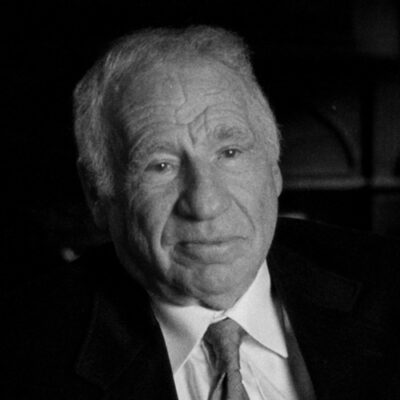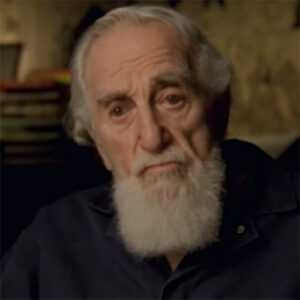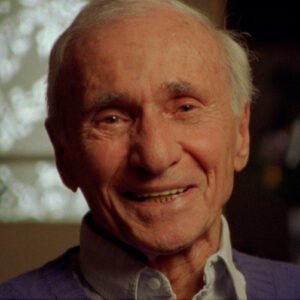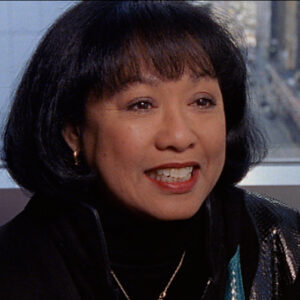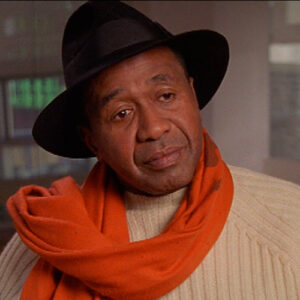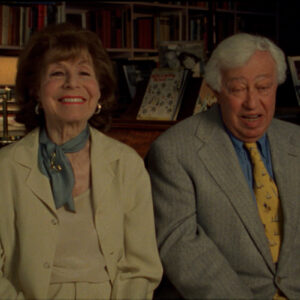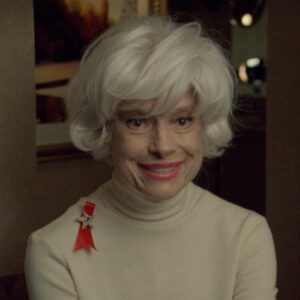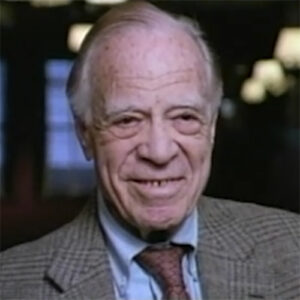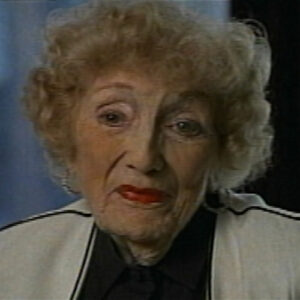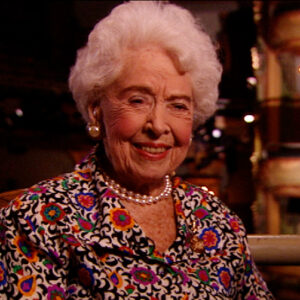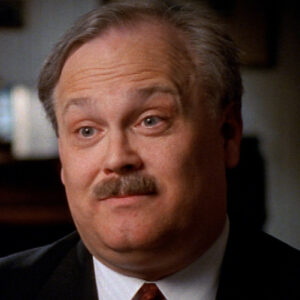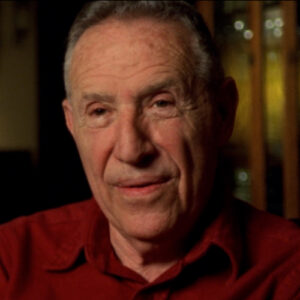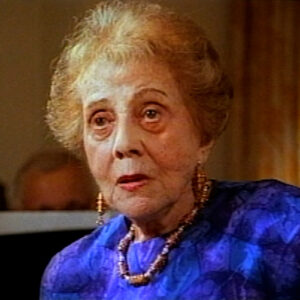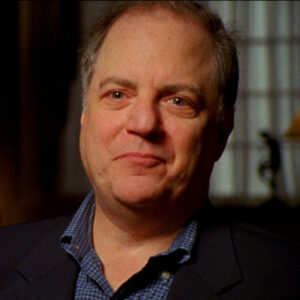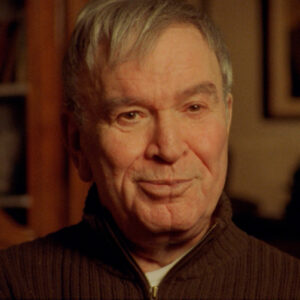Interviewer: So when you look at Cool, what does that number, what does it say about Jerome Robbins, about what kind of choreographer he was?
Jerry Mitchell: When I look at Cool, to me that number says that Jerry Robbins was a kick-ass choreographer who really knew what he was doing.
Interviewer: How so? What was so sort of special about his style?
Jerry Mitchell: There isn’t a wasted breath, a wasted moment. The movement is specific to the characters, specific to the situation in the story. And it’s moving the story along. Riff is saying to the gang, when it gets time, instead of blowing your top, play it cool. And that’s exactly what every movement in the show, in the number, happens. The characters, the characters explode and then… They recoil because Riff is watching over them. And Jerry once described it to the cast we were working on in Jerome Robbins’ Broadway, and he said, go home and put a pot of water on the stove and watch it boil. And he said drop something in it so it’ll overflow and then put the top on. That’s cool.
Interviewer: Great, great, great. Can you see his ballet background in that number?
Jerry Mitchell: Of course, you can’t do cool unless you have ballet technique. There are sautés, the piece is full of ballet technique, you have to be on your center. The last thing when they do the spin and they dip all the way down in a second position, up to an attitude, reach out and they’re in full releve with their hands extended, you can’t that unless you’ve got ballet technique
Interviewer: You were talking about how he choreographs for the individual and how the movement sort of expresses who the individual is and develops the story, but there’s that challenge and there’s the challenge of choreographing for the group, like a fight scene or, in this case, just the group of guys dancing together. What’s the, what’s the?
Jerry Mitchell: Cool is like a symphony. I mean, the funny thing about it is that one of the great things about choreography, and in particular, Jerry’s choreography, was he used bodies and groups of people to take different musical lines and express them. So you’ve got the group that’s slithering across the floor low. And then you’ve got the girls up high talking to each other. And then, you’ve the other group that are throwing daggers into the floor or knives into the floor and onto the ceiling. So you have all the different levels of the music being expressed by different groups. Then they come together and do the breakout section when everyone is doing the exact same step. But nobody’s facing the same direction. They’re all in their own head busting out. Because often, when people lose it, they just lose it. And they go in whatever direction they have to go. And Riff has to somehow pull them back together.
Interviewer: Did he ever talk to you about working with Leonard Bernstein or?
Jerry Mitchell: Well, Leonard Bernstein was around during Jerome Robbins’ Broadway, and they all were around. Stephen Sondheim, Leonard Berstein, Arthur Lawrence, they were all there, and I imagine I wasn’t around when they first created it, but you could see the type of relationships that they had for each other and the respect that they have for each in the piece, and it’s like collaborations I have with people my age. You know, we are of the same time, so you, uh… You sort of have an unspoken language when you’re working together, certainly after the life that West Side Story has had.
Interviewer: So let’s take a step back and just a bigger picture about Drogba. What did he, what was his impact on the Broadway musical? What did you bring to it that hadn’t been there before?
Jerry Mitchell: I am not a historian of the Broadway musical, so I can’t really say what Jerry Robbins brought to the Broadway Musical in a historical sort of answer, but I can certainly say for me, as a young choreographer, when I first worked with him, he taught me that dance isn’t about how high you kick your leg, it isn’t about how many turns you do, it’s about telling the story. And often, that can be done by simply sitting in a chair and raising your hand at the right beat. It’s what does the story require when no word can say it, either spoken or sung? There’s only one other way to tell the story in a musical, and that’s by movement. And he brought storytelling that moved the story along in musicals in a way no one else did. And he also was wickedly funny. And he brought an amazing amount of humor to his work. Max Senet Ballet, the Charleston Ballet Forum, all the things that he’d worked on, they had such humor. And that was a real gift. That’s a real in choreography.
Interviewer: What do you think it was like to dance for him back around the time of West Side Story?
Jerry Mitchell: Well, I think Jerry Robbins requires the same thing of anyone who’s in the room. What I require and everybody requires is dedication and commitment to the movement. We were once working on a piece for Jerome Robbins, Broadway, called Dreams Come True Ballet. And basically the story is that the girl is sitting reading photo play magazine on her couch, and Ramon Navarro and Gary Cooper, silent film stars pop out. Her imagination and and they dance with her and I was playing the Ramon Navarro part. And we were in rehearsals and we were just working on the piece trying to bring it back together and my dog was there Jerry was also very fond of dogs and I would bring my dog to rehearsal be golden retriever and he’d sit over in the corner and he watched rehearsal and I was playing I had to drink poison and pass out. And and die from the poison that she gave me and I drank the poison and he said and I died and he said oh no no no. No one will ever believe that. You weren’t committed to it. And he said, you have to do it like this. And he took the cup, and he drank the poison, and he died. And my dog went, hmm, hmm. And even my dog believed him. It was such an amazing moment of realization for me, because the fact is that the commitment is what makes the audience believe it. And that’s what he taught, and that’s what he believed in. He expected it from every dancer. And, uh… And it’s something that I expect from dancers that I work with.
Interviewer: You said something funny on the phone yesterday when you were talking about how it used to be a dictatorship, and now it’s more of a democracy, and you quoted Michael Bennett talking, saying that human rights had come to Broadway. Can you just talk about the sort of…
Jerry Mitchell: When Michael Bennett died, I was asked to interview for some books that were being written, and I was very young, and I didn’t really know if I had anything to say because the experience that I had with him on Scandal, which was the last musical he worked on, and then on Chess in London, they were personal experiences. You know, I’m an associate choreographer with him and Bob Avian, and so then I got to work with Jerry Robbins a few years later, and realized that they were. They shared a lot of similarities. Sometimes I would say they were the same person, but living in different time periods. And everybody said Jerry was a dictator, and he was really tough, Jerry Robinson. You know, he was, but he knew what he wanted. Well, Michael was the same way. Michael knew what wanted. And I appreciate that when I’m working with someone that they know what they want. But Michael once leaned over to me and said, the human rights have crept into the theater. Because what he meant was, the collaborative process with dancers and actors is different. Dancers are trained to come to class, stand at the bar, and do what’s asked of them. Actors are trained communicate with the director and do it together. And so dancers are more willing to come in and say, tell me what to do, tell me where to go, tell where to stand, tell how to kick my leg. Really classically trained dancers. That’s not necessarily the case with actors. So it’s about collaborating now, and it’s finding it together. And you can be a great director, you just have to know how to collaborate with people. It’s how do you work with people as opposed to demand things of people. That’s the difference nowadays.
Interviewer: Let’s go back to Jerry Robbins and Fiddler. The theme that they sort of came up with with the show is tradition. I mean, that was sort of a moment, I think, when they realized that that’s what they wanted to do. How did Robbins illustrate this through dance?
Jerry Mitchell: Tradition. It’s this, it’s that, it is everyone standing in a row holding hands or everyone together. It is the link, it the chain, it s the beginning of the show and it is going to break. Those traditions are going to be broken. I think it is that simple. It s the tradition of everyone holding hands, or everyone in unison with their hands held high in the air. This is the way it goes, this is the we live, this is what we believe in. This is tradition. And then suddenly somebody says, or I don’t want to do this, I want to this. And the tradition is broken. And Fiddler is about that. Fiddlers about a man who talks to God and says, why is change happening? Why do things have to change? And that’s what life is all about, change.
Interviewer: So Fred Astaire. Tell me about the language he uses as a dancer. What did he bring to the Broadway musical?
Jerry Mitchell: That’s a tough question for me. Fred Astaire and the Broadway musical, I wasn’t around to see any of it. The only things I know of Fred Astair are his movies. So, you know, what did Fred Astare bring to Broadway? I imagine he must have been spectacular to watch on stage. I never had that opportunity. I’ve only seen his films. His elegance, his grace, his charm, his style. You know, when you think of Fred stare you think this is. This is like watching pure gold dance. I mean, it doesn’t get any more stylistically beautiful, amazing rhythm. I understand he was an amazing drummer. And so the inner rhythm of his tap dancing is spectacular. He just was incredible. And I’ve been working on this new show, Never Going to Dance. And so I’ve studying a lot of his moves and the way he and how he moved and… You know, it’s just the period style. Everything’s just a little bent, a little crooked, a little turned in. He had incredible technique, but it was never like straight leg and pointed. It was a different style, different period.
Interviewer: Agnes DeMille, you were talking about storytelling and dance. How did she… To change the role of dance in the musical, the Oklahoma.
Jerry Mitchell: Again, I never saw the original production. The first production I saw was at the Palace Theater. And it was in the 80s, I think, early 80s. I saw a revival. And that was the first time I’d seen the original choreography for Oklahoma. And Agnes DeMille, again, was a storyteller. She moved the story forward in her choreography. She told the story in her choreography. In Brigadoon, which was the first Broadway show I danced in. I was picked by Agnes DeMille to be in the show. And at the audition, I was dancing my heart out, you know, Brise Batu and all this ballet stuff that I had just learned. I was fresh out of college. And she goes, I’ll take him. He can be a leader of the Klan. Again, it wasn’t about my dancing. It was about my height and my size and my look. I was right to tell the story. And she knew what that meant to tell the story in a music.
Interviewer: Great. Let’s move on to Michael Bennett. His background wasn’t in ballet.
Jerry Mitchell: Michael Bennett’s background wasn’t in ballet. No, I think Michael had ballet technique and training, but I don’t think that was his background. He was much more a tapper and jazz. Michael, it didn’t make him any different. Michael told the story. Michael used choreography to tell the story, he also used choreography to the story along with choreographing the sets, choreograpting the lights. He choreographed the entire package. In Dreamgirls, that show moves like a camera because everything is choreograph. The costumes, the sets, the people, everything is choreography. In a chorus line. Again, everything moves to tell the story. It’s not just how many turns and jumps and leaps, it’s when they back up, when they lift the picture to their face, when the walk forward, when every move is choreographed to tell the story.”
Interviewer: You are in a chorus line.
Jerry Mitchell: I wasn’t, of course.
Interviewer: Of course not.
Jerry Mitchell: Yes.
Interviewer: Was the stories that it tells, is it your story too in some way?
Jerry Mitchell: Yes, I mean I think every dancer has in a chorus line version of their own reality. I was very young, I was like five years old. I would go to dance class with my next door neighbor, Amy Firestone, and I would sit in the auditorium and watch her take class up on stage, tap and baton, and then we’d get home to her house and she wouldn’t remember the steps. And I’d grab the baton, and I’d do the steps, and I’d say, this is what your teacher did. Do it. So even at five, I was choreographing her before I knew what I was doing.
Interviewer: But just the sort of the struggle to make it as a dancer and this sort of dream of Broadway that’s leading you on, was that something that you?
Jerry Mitchell: I got involved in community theater myself when I was a really young kid. And I didn’t dance until I was 15. By the time I was 17, I was in love with dance. And I had been dancing in community theater. I saw a chorus line at the Schubert Theater in Chicago. I was the last row of the last balcony. I saw the show. I had never done a double pirouette. I went back to my dancing school to my teacher. I said, send me. Send me. I said you’ve got to teach me to do. Turn turn out in Jumpstep, which was in the opening combination. I took her back to see the show with her sister. We saw the show again. Two years later, the show, I was in college in St. Louis. The show was at the Fox Theater in St Louis. I auditioned. I got the show. And I went on tour with the show I had to be in the It moved me in a way nothing in my life had moved me when I saw that show. And when I went the first time, it was in Louisville, Kentucky. I was doing the opening combination and I remember thinking to myself, I wonder who’s in the back row. True story.
Interviewer: How did it move Broadway?
Jerry Mitchell: Again, Michael’s genius was the whole package of storytelling and the swiftness in which musicals are now told. Musicals used to bring in a drop or a curtain in one and they would do an in one number, a traditional in one while the scenery was being changed behind the curtain and then The curtain would fly out and you’d have a new set for the next scene. Musicals don’t work that way anymore. Technology is too advanced. And our society is too used to having things come at us like this, especially movies. So you don’t have the opportunity to stop, set it up, do the next scene. It all has to flow. In Hairspray, it was one of the challenges. And one of great things that we did was tried to make the show never stop, never have a blackout. We did the same thing with the Full Monte, Jack O’Brien, myself, the design team. The purpose was to continue the story. So Michael’s genius, certainly I learned from that, and I thought he was brilliant at it, was just that, making it continue. The shows were written and conceived and created so the story would continue. There was no blackout, there was no stopping. And you know, you’re taking on this joy ride often that by the end of it you go, oh my God, what did I just see? It’s a… It’s magical when theater can do that.
Interviewer: The song, What I Did for Love, what is that song about?
Jerry Mitchell: For me, personally, it’s, uh…
Interviewer: You could just put the question and your answer like this.
Jerry Mitchell: What I did for love is… Is, I think, for everyone who’s in this business, it’s… It’s why you do it. That’s why I do it.
Interviewer: In the finale of the chorus line, how does that affect audiences, or how does it affect us, how did it affect you?
Jerry Mitchell: Finale of A Course Line is pure joy. I mean, Bob Avian said to me once that they did that finale in about 20 minutes. They had worked and worked and then finally they had to do this finale and they just got up and they did it and boom, that was it. You do that finale in 20 minutes, that’s amazing. But often when you’re working on a piece and it’s going well. And everything is right, the song is right. What you’ve got up to that point is right everything is, right. Those things usually just, you just flip them and they just come out and they come out that way. And I believe that’s probably how it happened. I don’t know for sure. You’ll have to ask Bob Avey.
Interviewer: Tell me about the impact of AIDS on Broadway.
Jerry Mitchell: You know, dance in New York City, and particularly on Broadway, I think AIDS has impacted the theatrical community in a huge way, but more specifically, dance. In the early 80s, when AIDS really started to hit, I thought that dance sort of disappeared from theater. And I think, personally, that it disappeared because dance is sexual, and it’s a very The body expresses its You know, it’s a main way of expressing itself is with the body. And so a lot of the musicals lost dance. Now, suddenly, we’re learning to survive and live in a world with AIDS and dance is coming back into the pieces. And we’re getting the opportunity to tell a story in dance because I think we are. Not afraid to share ourselves sexually again. And sexuality and dance go hand in hand.
Interviewer: So let’s sort of take it from that revivals.
Jerry Mitchell: And collaboration. If the question is, what makes a musical successful, for me, I think it comes down to the structure of the musical, the storytelling of the music, which is in the music the lyrics, the book, and then the dances and the direction. And those are… What I call the structure of the musical. And when the structure is good, in the case of Gypsy, in the case West Side Story, and certainly what Jack O’Brien and myself and our collaborators were aiming at with the Ful Monte and Hairspray is the structure, the storytelling structure. The show has an opportunity to be successful beyond possibly its first showing. For other people to inhabit the roles, and for it to be done in other places, because the story is strong. The story is there. And that’s when collaboration can be the most successful. Usually there’s somebody leading the charge. It can be a director, the choreographer, the composer, the writer, or the lyricist. And usually it’s probably whoever’s at the top of the food chain at that time. But having the ability to collaborate with those people. And follow one direction, your chances of hitting a home run, I think, are far greater.
Interviewer: How do you approach a revival versus a new production? Like, are you more excited about something that’s new, like hairspray, where you just created it out of thin air?
Jerry Mitchell: You have to approach everything that you do, I believe, even if it is a revival, as if you’re doing it for the first time. You have invest in the material a full commitment. It’s the same thing as a dancer, in that Jerome Robbins story I was talking about. You have be totally committed to this, and you have to believe in it as if you’re doing it the first. You have remember the people who are coming into the theater to see it, it may be first time hearing this story. You want to give it original ideas, original thoughts.
Interviewer: What does a dancer do on Broadway that he doesn’t? What’s so special about dancing for a Broadway show as opposed to other types of dancing?
Jerry Mitchell: Well, what’s special is that when you’re performing on stage, you’re in front of an audience. And that audience is giving you instant communication. It’s like communion. You’re sharing with that audience, and they’re giving you instant feedback. And you can’t get that when do a film. You can’t that when when you do a television show. When you’re dancing for a live audience, the response is instant. And that makes it extra special for me.
Interviewer: What does the Broadway musical say about America? Because it’s something that we created.
Jerry Mitchell: I know. You asked me about this. You know, what does it say about America? I think it says a lot of things about America. There isn’t one type of musical, but what it does say about us is that we’re a nation that likes to be told stories. And sometimes those stories can be historical, and they can pass on information. Sometimes they can change the way you think, and sometimes they can make you laugh and educate you all at the same time.
Interviewer: Just think about hairspray, because to me, that was just it. Hairspray. Hairsprays.
Jerry Mitchell: Hairspray is a musical that actually asks the audience to have a great time, and when they leave, think about why they had a great time. It’s not just all fun and games. We’re actually saying that, you know, you don’t have to be skinny to get the boy. You don’t have to be the most popular person to win the prize. You don’t to be white to dance on the Corny Collins show. You can get there, you know, and that’s a great message. It’s a message for young kids.
Interviewer: Great. Which Broadway show influenced you the most?
Jerry Mitchell: You know, I never saw a Broadway show until I was 17. And the first Broadway musical I saw was The Wiz. I was touring the nation in a production of West Side Story. And we came to New York in a layover. And I saw The Wiz, and I just remember the hair standing up on the back of my neck. It was so magical. But being in, and being a part of a chorus line at 20, and touring in that show. Performing and telling that story was a life, it changed my life. I knew at that moment, I knew before that, but I think that solidified it, that there really wasn’t any place else for me, there wasn’t anything else for me to do but the Broadway musical. So you asked me about the success of a Broadway show. The funny thing is, is when you’re working on a Broadway musical, you’re never prepared for the success of the show, you are always prepared for the failure. Because… We are underdogs as people. We’d rather fight going up the hill. And I have 13 or 14 kids who are making their Broadway debut in Hairspray. And with the certain amount of admiration they’ve received so far and the success they’ve received so far in the show, it’s hard for me to get across to them that not every musical they do. Will be they will be lucky enough to have this experience to be asked to do every TV show to be ask to do every extra thing to make the extra bucks to do the extra stuff it’s a responsibility eight shows a week and doing that work That success is rare. And there are a lot more letters in the word business than there are in the words show. It’s a business, we’re in a business. We want to make good product, we want it to be successful, but we also have to somehow get the people in the seats.
Interviewer: Why should anyone care about the Broadway musical, the fate of the Broadway Musical, that Broadway Musical is a form of art?
Jerry Mitchell: Why should people care about the fate of the Broadway musical as an art? Why should you care? Why should…
Interviewer: Not as an art, but like, as an artwork.
Jerry Mitchell: Why should people care about Broadway musicals? Period, why should they? Why shouldn’t they? I don’t ask why, I ask why not. Because we have to have something to sing about. And dance about.
Interviewer: On his left Broadway in 1964, who was the sort of next in line as the great choreographer and director on Broadway?
Jerry Mitchell: When Jerry left Broadway, Jerry Robbins, I think Michael Bennett, I think Tommy Toon had some wonderful shows. I think Ron Field was still working and did the original cabaret, it was brilliant. I think there were a lot of people who followed in his I think every director, choreographer on Broadway follows in the footsteps of those that go before them. Is there one specific person? I hope not. I hope that there will be several directors and choreographers who are offered the opportunities and come through. And I think there are many working in New York now who I’m certainly fond of and look forward to seeing their future work. Type of entertainment in the way in which it’s delivered, but ultimately it doesn’t matter if it’s danced, sung, or acted, it’s coming down to the story. On Broadway. It’s the story and the entertainment.

